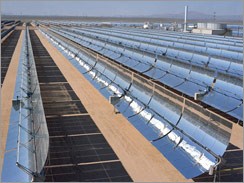The solar photovoltaic industry in Ontario and around the world is growing at an unprecedented rate, creating the jobs that underpin a green economy and a sustainable power grid. With this growth came an increased demand from industry for high-quality research in solar systems design and optimization in realistic (and sometimes extreme) Canadian outdoor environments. To answer this need, a partnership has formed the Open Solar Outdoors Test Field (OSOTF). The OSOTF was originally developed with a strong partnership between the Applied Sustainability Research Group run by Dr. Joshua Pearce at Queen’s University and the Sustainable Energy Applied Research Centre (SEARC) at St. Lawrence College headed by Adegboyega (Babs) Babasola. This collaboration has grown rapidly to include multiple industry partners and the OSOTF has been redesigned to provide critical data and research for the team.
The OSOTF is a fully grid-connected test system, which continuously monitors the output of 95 photovoltaic modules and correlates their performance to a long list of highly accurate meteorological readings. The teamwork has resulted in one of the largest systems in the world for this detailed level of analysis, and can provide valuable information on the actual performance of photovoltaic modules in real-world conditions. Unlike many other projects, the OSOTF is organized under open source principles. All data and analysis when completed will be made freely available to the entire photovoltaic community and the general public.
The first project for the OSOTF forms Rob Andrew’s graduate thesis at Queen’s, which quantifies the losses due to snowfall of a solar photovoltaic system, generalizes these losses to any location with weather data and recommends best practices for system design in snowy climates. The results of this study will be available at the end of the summer. Future projects at the OSOTF will investigate novel systems layouts, low-level concentration, and the effects of spectral composition on solar cell performance. In addition the system will be used for technology and module comparisons and validations, as well as multiple specialized research programs going into the future.
This system has been made possible by the Natural Sciences and Engineering Research Council of Canada and generous contributions and collaborations from: Advanced Solar Investments Ltd., AYA Instruments, Dupont Canada, eIQ Energy, Heliene Inc., KACO New Energy Inc., Nanofilm, Photovoltaic Performance Labs Inc., Schueco Canada, Silfab Ontario, Sustainable Energy Technologies Ltd., Universidad Privada Boliviana, and Uni-Solar Ovonic LLC.
The development of this cutting edge test facility is a testament to the commitment of the photovoltaic industry to continuous innovation, and will be a valuable tool for ensuring the development of a sustainable power system worldwide.
Get more details at http://www.appropedia.org/OSOTF or real time images: and
Related articles
- United States Solar Photovoltaic Project Order Backlog Surpasses 12 GW (visitsunworks.wordpress.com)
- Reportlinker Adds Global and China Photovoltaic Inverter Industry Report, 2010-2011 (prnewswire.com)



